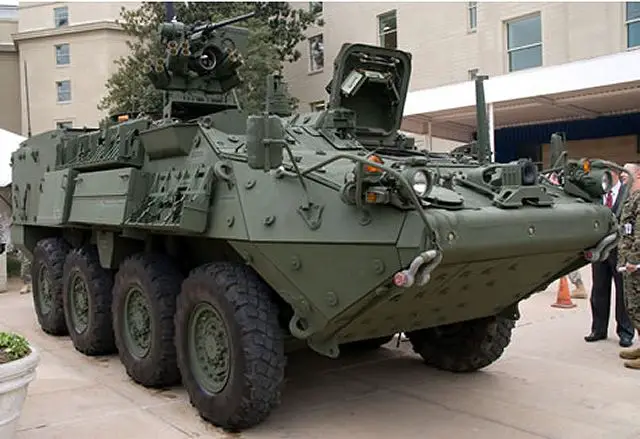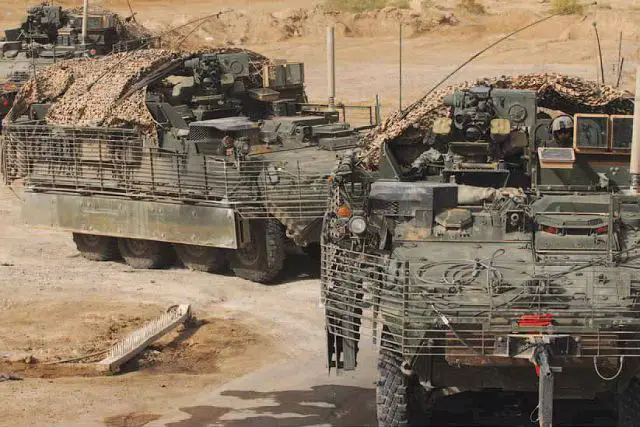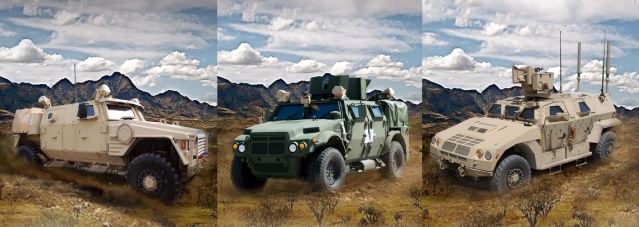United States Army Stryker double-V hull vehicle save lives of U.S. soldiers in Afghanistan 0603126
| a | |||
Military Defense Technology News - United States |
|||
| Tuesday, March 6, 2012, 04:44 PM | |||
| United States Army Stryker double-V hull vehicle save lives of U.S. soldiers in Afghanistan. | |||
The
United States Army expects final delivery of additional Stryker double-V
hull armoured vehicles, the Stryker DVH, by year's end and expects to
then have a total of about 760. "To hear from the field, back from
Soldiers and commanders about the value of the double-V hull, it is truly
remarkable," said Lt. Gen. Bill Phillips, principal military deputy
to the assistant secretary of the Army for Acquisition, Logistics and
Technology. ( U.S. army By C. Todd Lopez) |
|||
 The Double-V-Hull adds on Stryker armoured vehicle to increase protection for the crew against land mines and IEDs blast |
|||
| |
|||
To
date, Phillips said, there have been about 40 incidents where the double-V
hull has encountered an improvised explosive device, known as an IED,
and with the exception of two incidents, all of the Soldiers walked away
with just minor injuries. |
|||
 The double-V hull on new Strykers is saving lives in Afghanistan, acquisition officials say, adding that over 400 more of them will be fielded this year. (Photo Credit: U.S. Army photo) |
|||
PELVIC
PROTECTION Another success in theater, Phillips said, includes the Tier I and Tier II Pelvic Protection System. The Army wanted to do something to offer protection to Soldiers. Taking a cue from British forces that had already found a material solution to the problem, the Army developed the Pelvic Protection System. The system includes two layers of protection for Soldiers, including the Tier I protective under-garment, called the "PUG," and the Tier II protective outer-garment, called the "POG." Both components of the system are worn like shorts. The PUG is worn under a Soldier's ACU pants and has a breathable, moisture-wicking material on the outer thighs. Along the inner thighs is knitted Kevlar to protect the fleshy inner parts of the thighs and the femoral artery. Over the groin, more knitted or woven Kevlar. The outer garment, the POG, provides even more protection for Soldiers, and performs similar to the soft portions of the improved outer tactical vest. The Army has fielded just more than 15,000 Tier II garments and more than 52,000 Tier I garments. Three Soldiers who encountered IEDs while on patrol in Regional Command South in Afghanistan had been wearing the Pelvic Protective System. Two lost part of one or both legs -- but their groin area, Phillips said, survived, as did their pelvic area. The third Soldier lost both legs and suffered severe damage to his pelvic region -- but his groin area was intact. "As soon as that was understood by Soldiers throughout the formations, that went through the command like wild fire," Phillips said. "And Soldiers are now wearing undergarment protection, pelvic protection." |
|||
 United States Army officials say industry is ready now to begin developing the Joint Light Tactical Vehicle for the Army. While multiple prototype JLTV vehicles exist, the Army has yet to choose one as the service's newest vehicle. Left - Lockheed Martin , Center - General Dynamics, Right - BAE Systems |
|||
ACQUISITON
REFORM AND JLTV In July, the Army released the "Decker-Wagner" review of its acquisition processes. The panel that produced the report was chaired by Gilbert Decker, a former Army acquisition chief, as well as Gen. Lou Wagner, the now-retired former chief of the Army Materiel Command. Phillips said the Army has already implemented 29 of the 76 recommendations in the report, and will implement a total of 63 of those recommendations total -- with the majority complete by the summer. As a result of the study, Phillips said, the Army has revised the way it looks at requirements. Now, he said, the service is looking at what capabilities a requirement provides, is it feasible in terms of execution on the timeline, and is it affordable. One beneficiary of the Army's new acquisition processes is the Joint Light Tactical Vehicle. Phillips said the JLTV might have cost the Army close to $500,000 per vehicle if the Army had gone forward with the strategy it had during the technology development phase of the vehicle. Today, he said, as a result of how the Army changed the way it does requirements "we are confident we can bring this vehicle in for less than $250,000." Phillips also chided "naysayers" of Army acquisition -- those who say Army acquisition can't deliver. Phillips cited the mine-resistant, ambush-protected vehicle, known as an MRAP, the MRAP All-Terrain Vehicle, the 60-plus upgrades to the M4 carbine, the M240L light machine gun, and the proliferation of unmanned aerial vehicles as examples of how the Army is delivering to the force what Soldiers need to complete the mission. "The myth is Army acquisition can't deliver," Phillips said. "The truth is, we have delivered for our Soldiers." |
|||


























